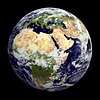LHS 1140 b
 Artist's impression of the planet LHS 1140 b and its host star | |
| 发现 | |
|---|---|
| 发现者 | MEarth计划(The MEarth Project) |
| 发现日期 | 20 April 2017 |
| 凌日时间变分法 | |
| 轨道参数 | |
| 半长轴 | 0.0875 (± 0.0041) AU |
| 离心率 | <0.29 |
| 轨道周期 | 24.7369148+0.0000058 − d[1] |
| 轨道倾角 | 89.912 (± 0.071) |
| 物理特征 | |
| 平均半径 | 1.641+0.048 − R🜨[2] |
| 质量 | 6.48+0.46 − M🜨[2] |
| 平均密度 | 7.82+0.98 −0.88 g/cm3 |
| 表面重力 | 2.41 g |
| 温度 | 254 K(−19 °C;−2 °F) |
如何发现
LHS 1140b 是由MEarth计划发现的,这使用了高精度径向速度行星搜索器(HARPS) 进行的多普勒光谱观测,而证实了它的存在。
特征
主星
LHS 1140b 距离主星LHS 1140 1309 万公里(0.09个天文单位)运行,它以大约 25 天的周期公转。主星距离只有太阳到地球距离的8%,但由于LHS 1140 只是一颗质量和半径比太阳小15%的小红矮星,[3]所以热量和能量由 LHS 1140b 接收到的,只是大约是地球接收到的阳光量的一半。
质量和半径
↑ 上方是地球和LHS 1140 b 的大小比较。
LHS 1140 b质量约为地球的6.7±1.8倍,半径约为地球的1.4±0.1倍[4][5]。它的质量比地球还大。因此,LHS 1140b很可能是超级地球(Super Earth)。
由于相对于质量半径小,密度高,所以表面的重力是地球的三倍以上。相信自诞生以来已经过去了超过50亿年。
温度
LHS 1140 b表面温度为230 K(-43°C)。由于主星LHS 1140不是活跃的恒星,因此不受强辐射的影响。因此,如果有大气产生温室效应,液态水和生命的存在是可能的。
大气
LHS 1140b 是一颗距离相对较短的行星,距离地球约 40 光年。此外,还能观测到行星在恒星前方经过的凌日,有可能得到行星的大气成分。未来还会计划用哈勃太空望远镜观测 LHS 1140b 。
| 条件 | 地球 | LHS 1140b | ||
|---|---|---|---|---|
| 球面反照率 | 0.3 | 0.9 | 0.6 | 0.3 |
| 没有温室效应 | -17℃ | -149℃ | -98℃ | -72℃ |
| +地球的温室效应 | 15℃ | -117℃ | -66℃ | -40℃ |
参考资料
- ^ Hubble WFC3 Spectroscopy of the Habitable-zone Super-Earth LHS 1140 b, 2020, arXiv:2011.08815

- ^ 2.0 2.1 Planetary system LHS 1140 revisited with ESPRESSO and TESS, 2020, arXiv:2010.06928

- ^ Dickinson, David. Welcome to LHS 1140b: A Super-Earth in the Habitable Zone. Sky & Telescope. 2017-04-19 [2017-04-19]. (原始内容存档于2018-09-08).
- ^ Dittmann, Jason A.; Irwin, Jonathan M.; Charbonneau, David; Bonfils, Xavier; Astudillo-Defru, Nicola; Haywood, Raphaëlle D.; Berta-Thompson, Zachory K.; Newton, Elisabeth R.; Rodriguez, Joseph E.; Winters, Jennifer G.; Tan, Thiam-Guan; Almenara, Jose-Manuel; Bouchy, François; Delfosse, Xavier; Forveille, Thierry; Lovis, Christophe; Murgas, Felipe; Pepe, Francesco; Santos, Nuno C.; Udry, Stephane; Wünsche, Anaël; Esquerdo, Gilbert A.; Latham, David W.; Dressing, Courtney D. A temperate rocky super-Earth transiting a nearby cool star. Nature. 2017, 544 (7650): 333. doi:10.1038/nature22055.
- ^ Overbye, Dennis. A New Exoplanet May Be Most Promising Yet in Search for Life. New York Times. 2017-04-19 [2017-04-20]. (原始内容存档于2020-11-11).
- ^ HEC: Exoplanets Calculator Planetary Habitability Laboratory (页面存档备份,存于互联网档案馆) Planet Equilibrium Temperature
Text is available under the CC BY-SA 4.0 license; additional terms may apply.
Images, videos and audio are available under their respective licenses.


